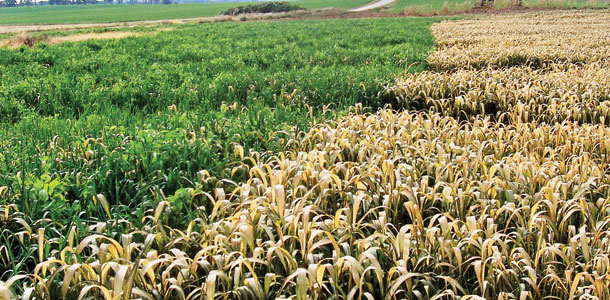Double Crop Forage Options

With much of the country experiencing a forage shortage, there is still a good opportunity to build forage inventories by double cropping this year. In the northern half of the country there will be millions of acres coming open with wheat and vegetable harvest. Farther south there is a good opportunity to grow good feed following corn silage or sorghum.
Deciding what forage to grow can be challenging because there are so many options. Generally, I start by asking my clients 4 questions:
1. What quality of forage are you targeting?
This is always a good question to start with because the worst thing we can do is grow lots of forage that doesn’t fit our nutritional goals. If this will be fed to lactating cows at a high inclusion rate the species, we select will be much different then if we are needing a fiber source for heifer diets. I once had a new client who brought me in because they had just grown 40k tons of a non-BMR sorghum and their nutritionist wouldn’t feed it. This could have been easily been avoided by a discussion prior to planting.
For lactating cows, I usually am picking from a cool season pool of Annual/Italian rye grass, Fall forage oats, Forage Barley, hybrid brassicas and legumes, or a warm season pool of PPS BMR sorghum sudan, BMR millet, cow peas and soybeans or a combination of the above.
2. How many days until an expected frost?
Warm season crops should be planted at least 60 days before your expected first frost. Even if you haven’t froze, GDU accumulation slows rapidly towards fall and it will be hard to maximize the fall forage crop.
Cool season mixes should be planted 30-45 days before the first frost. If they are planted too early the heat will diminish growth and will push small grains to go reproductive prematurely. The goal is to time up cooling days with increased maturity. This will extend the days of forage production and increase quality.
3. Do you want the crop to over-winter?
The beauty of many fall forage mixes is that we can get multiple cuttings between the fall and early spring if we design and mange them correctly. By combining forages that over-winter like rye grass, clover and winter triticale with other forages like oats and kale, we can harvest a great cutting in the fall and another cutting or 2 the following spring. This reduces planting costs and provides ground cover. Many of my farms do not want things to over winter. They may be sub-renting wheat ground from cash-croppers who want a clean field in the spring. In those cases we stay with forages that are sure to winter-kill.
4. Do you value a legume for cover-crop purposes?
Many grain farmers follow their cash crop with a cover-crop to lower fertilizer expense and to increase soil health. Some of my livestock farmers have reached agreements that benefit both parties. For example, a dairy farmer I work with just rented 800 acres of wheat ground from a grain farmer. He agreed to spend $70 on fertilizer so it didn’t deplete the soil, plant clover with the forage mix so the grain farmer got a free cover-crop and to give the grain farmer $25 an acre for use of the ground. I expect this dairy farmer will be able to grow 2-4 tons dry matter of good feed for a very reasonable price on this ground.
Cocktail Mixes
I have mainly been using 3 different cocktail mixes on farms around the country. The most popular mix is a combination of BMR sorghum sudan, Italian Rye Grass and legumes. This mix can be planted after wheat in the upper Midwest and after corn silage in the southern Midwest. It will give a good cutting in the fall and provide a winter cover with the potential for another big cut in the spring.
We have also been planting Oats, winter triticale, Red clover and annual rye grass approx. 30-45 days before frost. This also will give us a fall cut and a spring cut.
For a warm season mix that winter-kills I have been planting BMR Photo-period sensitive Sorghum sudan, BMR pearl millet and cow peas. We can plant this after corn silage in the south and get a big cutting or after wheat or vegetables in the north.
As land values increase the need for increased yields keeps growing. One way to accomplish this is to make sure we are utilizing every growing day of the year by utilizing the right forages in a double-crop system.







